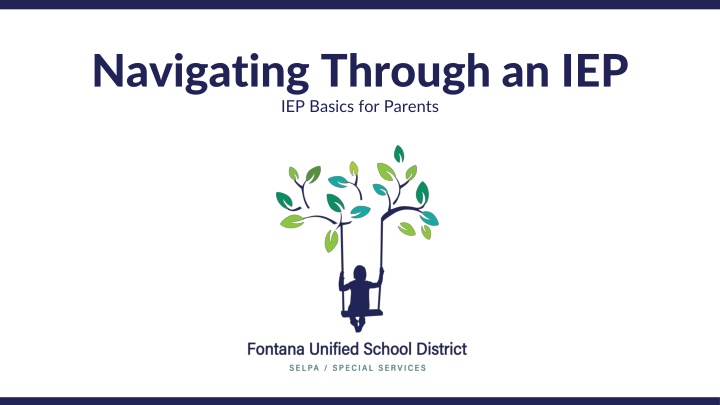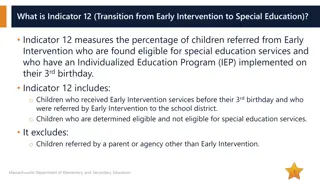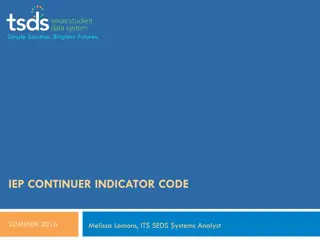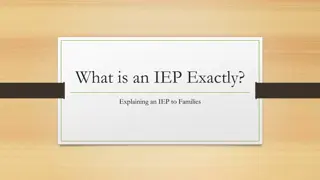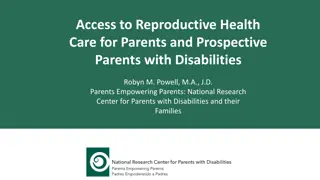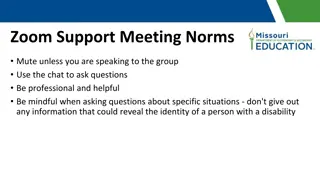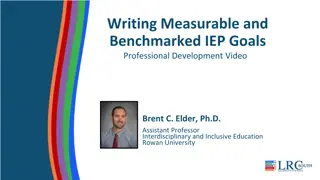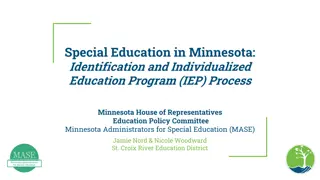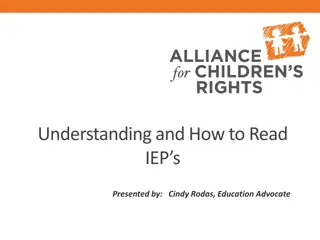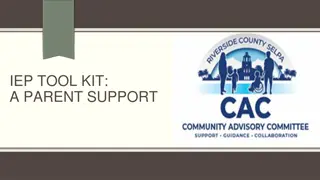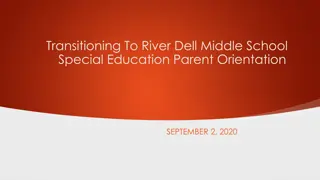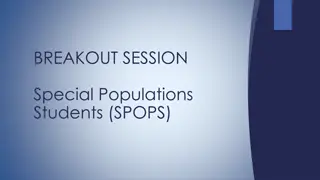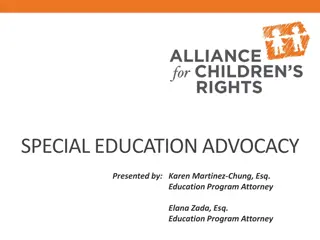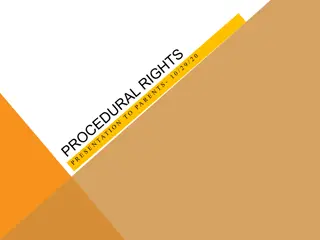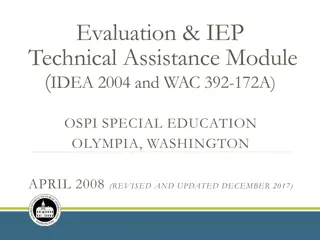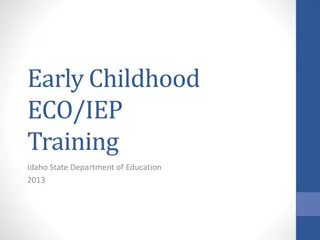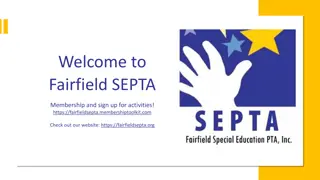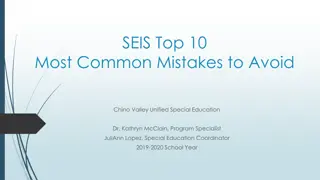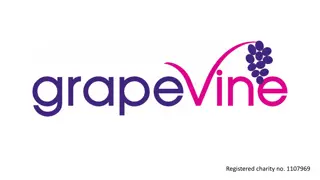IEP in Special Education: A Comprehensive Guide for Parents
Exploring the components and requirements of Individualized Education Programs (IEPs) in special education, this guide delves into navigating through an IEP, learning goals for educators, Fontana SELPA's mission, and understanding procedural safeguards for parents. It emphasizes the importance of parental participation, rights, and responsibilities in the IEP process, ensuring quality education and support for students with exceptional needs from ages 3 to 21.
Download Presentation

Please find below an Image/Link to download the presentation.
The content on the website is provided AS IS for your information and personal use only. It may not be sold, licensed, or shared on other websites without obtaining consent from the author.If you encounter any issues during the download, it is possible that the publisher has removed the file from their server.
You are allowed to download the files provided on this website for personal or commercial use, subject to the condition that they are used lawfully. All files are the property of their respective owners.
The content on the website is provided AS IS for your information and personal use only. It may not be sold, licensed, or shared on other websites without obtaining consent from the author.
E N D
Presentation Transcript
Navigating Through an IEP IEP Basics for Parents
Learning Goals Participants will be able to navigate all components of SEIS Participants will gain a foundational understanding of the components and requirements for an IEP Navigate day to day teaching responsibilities as a special educator
Fontana SELPA Special Services Department The office of Special Services, Special Education Local Plan Area (SELPA), is dedicated to providing quality Specialized Academic Instruction (SAI) support and services for students, ages 3 through 21, identified as requiring special education and related services. It is the policy of the Fontana Unified School District (FUSD)/ SELPA that all children with disabilities residing within FUSD boundaries, regardless of the severity of their disability and who are in need of special education and related services, are identified, located, and evaluated. Special Services works collaboratively with the school sites, district departments, agencies and parents to provide the services required to meet the unique need of our students who are eligible for special education and related services.
Fontana SELPA Mission The mission of the Fontana Special Services Department is to provide equitable, inclusive, and quality education to students with exceptional needs by providing supports, services and resources to students, staff, parents, and the community to prepare students for success in college, career, and postsecondary life.
Must be provided when: What is the Notice of Procedural Safeguards? At each IEP meeting Initial referral for assessment Each time an Assessment Plan is An overview of educational rights and procedural safeguards presented Upon receipt of the first state or due process complain in a school year Decisions that result in a change in placement When you ask for a copy
You have the right to participate in meetings about ELIGIBILITY, ASSESSMENT, or EDUCATIONAL PLACEMENT. Procedural Safeguards Explained: You have the right to participate in the development in the IEP. Participation Participation You have the right to audiotape the proceedings with at least 24-hour prior notice. You have the right to discuss all program options and be given that information.
Classroom Teacher(s), Case Carrier, School Psychologist Procedural Safeguards Explained: School Site Administration Special Education Local Planning Area (SELPA) Office Who can provide support? Parent Organizations California Parent Organizations- Quality Assurance Process (CA Dept of Education)
PWN- when a school district proposes or refuses to initiate a change in eligibility, assessment, educational placement or Offer of FAPE Procedural Safeguards Explained: A description of action proposed An explanation of why Prior Written Notice (PWN) A description of each assessment procedure Statement related to the Procedural Safeguards Resources A description of other options considered by the IEP team Other relevant factors
You must give informed written consent within 15 days IEP is developed within 60 days of your consent Written consent must be given before services can commence If you consent in part, those parts must be implemented You may revoke consent in writing Procedural Safeguards Explained: Parental Consent
Surrogate Parent Appointment Other Components of the Procedural Safeguards Non-discriminatory Assessment Independent Educational Assessment Access to Educational Records
How Are Disputes Resolved? Due Process Hearings are an impartial hearing regarding the identification, assessment, educational placement or the provision of FAPE ADR Mediation Pre-hearing mediation conference Due Process Rights Written Complaints
Intervention To Assessment Student Intervention Team (SIT) Process: Step 1- Parent, teacher or other professional identifies a concern. Step 2- School site holds an SST (student support team) meeting and determine interventions for student. Step 3- Provide interventions for a meaningful period of time. Step 4- If interventions resolve the concern, continue interventions. If not, adjust interventions. Step 5- Team meets again if interventions still not successful. Possible referral for special education assessment.
Assessment Process A referral is made by parent, SST or other knowledgeable person for special education assessment Parent is provided an assessment plan within 15 days of referral Parent is provided 15 days to consent to assessment plan Parent may request a meeting to discuss assessment plan If parent consents, the assessment is completed within 60 days of receipt of parent consent IEP meeting is held to discuss assessment results If student qualifies, assessment establishes disability
13 Eligibility Categories Autism (AUT) Deaf- Blindness (DB) Deafness Hearing Impairment (HI) Intellectual Disability (ID) Emotional Disturbance (ED) Multiple Disabilities (MD) Orthopedic Impairment (OI) Other Health Impairment (OHI) Specific Learning Disability (SLD) Speech or Language Impairment (SLI) Traumatic Brain Injury (TBI) Visual Impairment (VI) Assessment establishes eligibility Student must require special education services to be eligible for special education, regardless of disabling condition
What Is An IEP? An IEP is an Individual Education Program for a student who is eligible for special education services An IEP is meant to address a child s unique learning needs It is a contract for special education services
IEP Team Members Parent General Education Teacher Administrator or Admin Designee Special Education Teacher or Designated Service Provider(s) Student (when appropriate and when discussing post-secondary transition) Other individuals with knowledge and/or expertise regarding the student Anyone who can interpret the instructional implications of the evaluation if an assessment was conducted
Parent Consent Parent has the right to Consent to all parts of the IEP The IEP will be implemented within a reasonable amount of time Consent to some parts of the IEP Only portions of the IEP that the parent consented to will be implemented Decline the offer of initial special education services The IEP will not be implemented Not consent to the IEP The IEP will not be implemented, goals and services listed in the last consented IEP continue
Consent (Continued) A parent may revoke their consent to all special education services. This must be done in writing The district will send prior written notice explain the school placement and that the student will no longer have protections under IDEA A parent may take an IEP home to review before providing consent
IEP AGENDA SAMPLE IEP Agenda Sample 1. 2. 3. 4. 5. 6. 7. 8. 9. 10. 11. Introductions Procedural Safeguards Parent Concerns/ Input Assessment Reports Present Levels Accommodations, State Testing, Special Factors Progress on Goals Goals and Objectives Supports and Services Placement/ Offer of FAPE Consent/ Signatures
Parts Of An IEP Forms Within an IEP 1. 2. 3. 4. 5. 6. 7. 8. 9. Notice of Meeting IEP Team Member Excusal Form Information and Eligibility Present Levels of Academic Achievement and Functional Performance Special Factors Statewide Assessments Individual Transition Plan (16 years old +) Annual Goals and Objectives Offer of FAPE- Service Offer of FAPE- Educational Setting IEP Team Meeting Notes Emergency Circumstances Program Signature and Parent Consent Prior Written Notice (PWN) 10. 11. 12. 13.
PREPARING FOR THE MEETING Make a list of priorities and concerns Contact the case carrier to discuss goals Make requests for additional services, testing, or IEP meetings in writing District is responsible for providing parent with reasonable notice of IEP
Other Information A parent may request an IEP. Just put it in writing and the District will hold a meeting within 30 calendar days (with the exception of breaks consisting of more than 5 days) A parent may request copies of existing student records. The District will provide copies within 5 business days Parents may request copies of draft IEP and assessment reports prior to the meeting. If available, the District will provide draft copies A child placed by parent in private school has the right to a service plan but not FAPE
OTHER INFORMATION If you disagree with your child s IEP, assessment or services you may request intervention at the local level or state level: Local Level Case manager/school site SELPA office/Coordinator Alternative Dispute Resolution State Level CDE complaint or Due Process filing
Other Information If your child is recommended for expulsion or is removed from school placement for over 10 days, the district must hold a Manifestation Determination IEP to determine if the behavior was caused by the disability or a result of the district not providing services in the IEP A parent has the right to request an IEE (Independent Educational Evaluation) at public expense if they disagree with results of the district assessment. The district either grants the request based on policy or has to file for due process to support the district assessment
Other Information A parent may request to audio tape an IEP meeting. If this action is desired, a 24-hour notice is required All rights transfer to the student whey they reach the age of 18 (Age of Majority) unless they are conserved by the courts
Family & School Partnerships Have you ever wondered or thought How do I communicate with my child s school? What happened? How did we get here? Did I miss something? What did I do wrong? What is the school doing? Wow, that meeting went so great how can we keep this up? What made this meeting work? I am worried, who should I talk to first? Who can help me? Am I all alone? Have you ever had an issue? Have you had things work out great? What did you do to make things go smoothly? What did the school do?
Working Together Toward Solutions Developing a positive relationship with your child s teacher is the first step to success If your child sees you respect the teacher, then they know they can trust them Developing communication is important
Communication Communicating with school personnel is not always easy. Both staff and parents need to find the best way to communicate for the specific situation. Email - Good for short questions and simple information. Be brief, choose your words wisely (a misplaced comma can change the meaning of a sentence), stick to the topic, use open ended questions, Can we talk about that ? What are your thoughts regarding ? When is a good time to meet ? Phone Calls Great way to dialogue on a topic Notes Home- Like email, responses to questions, obtaining information, asking simple questions providing information Meetings - More complex issues that need problem solving, dialogue, multiple people involved
Effective Communication Skills Make eye contact Give the speaker your undivided attention Body language Speak in a positive tone Be an active listener Speak concisely Be open-minded
Working Together At IEP Meetings Be organized Create an IEP folder Communicate issues to staff before the meeting Create a list of questions/concerns more gets done if people are prepared Be on time Prepare questions and concerns Bring a positive attitude Hope for the best but be prepared to ask questions Remember, the IEP is an ever-changing document and is individualized to your child
Advocating During The IEP Write down your concerns before the meeting Review the IEP document and notes Write a parent comment after the meeting with your consent if you feel something is missing Ask open ended questions. Why do you believe ? Have you considered ?
Advocating After The IEP Put your requests and concerns is writing Ask for an IEP team meeting Put the request in writing Ask for a meeting with the teacher or administration or other staff to help you understand the school s offer Consent only to what you agree with in the offer The school will implement the services that you agree with and will work with you to resolve the remaining issues
Seek Mutual Purposes Try to find mutual areas of agreement Be open to other choices/ideas Communicate your core needs and beliefs Stay focused on the needs of your child Ask questions, the only bad question is the one NOT asked
WHAT TO DO IF THINGS ARE NOT WORKING? 1. Ask for a facilitated IEP Team Meeting 2. 3. Request a meeting with District Administration Call your SELPA and find out what local dispute resolution is available 4. File a CDE complaint 5. Mediation only request If all else fails: You have the right to file for DUE PROCESS
Collaboration Is The Key Positive relationships lead to student success
